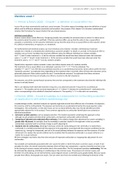Samenvatting
HCM Advanced Research Methods (literature summary)
Summary of the most important mandatory literature of the course: advanced research methods. The following articles are included: - Hernan & Robins (2020) – Chapter 1: a definition of causal effect - Hernan (2002) – Causal knowledge as a prerequisite for confounding evaluation: an applica...
[Meer zien]




